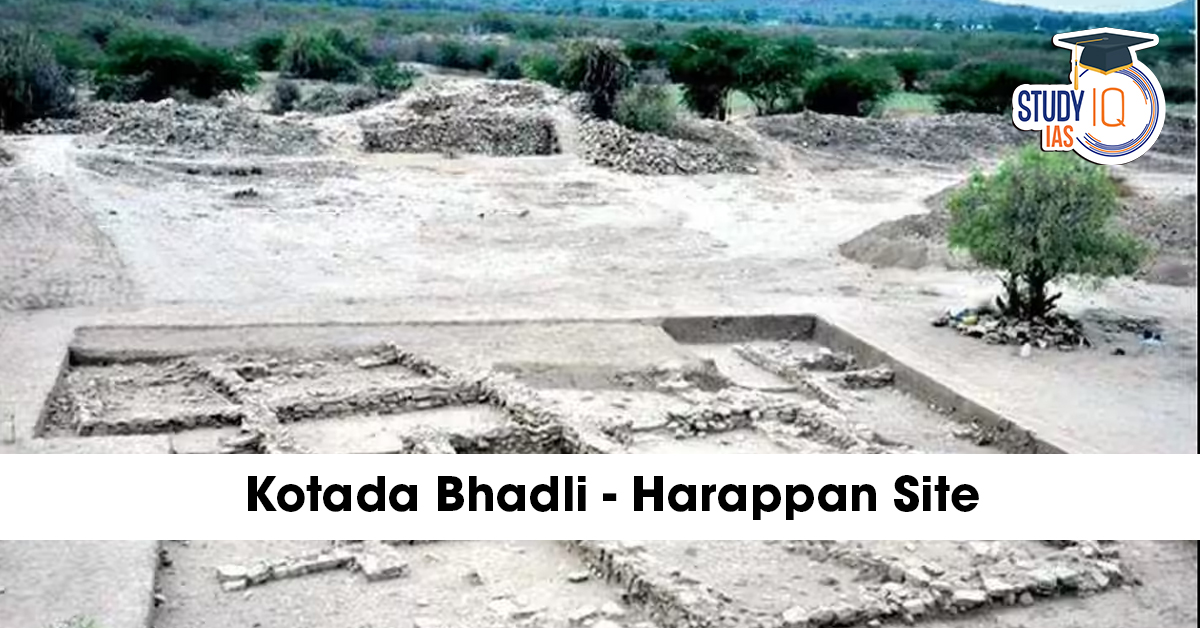Table of Contents
Archaeology has once again rewritten the timeline of India’s ancient trade systems. A recent study by the Deccan College Post-Graduate and Research Institute (Pune), Symbiosis School for Liberal Arts, and the Archaeological Survey of India (ASI) has revealed that the Harappans had a sophisticated trade-support infrastructure nearly 4,000 years ago at Kotada Bhadli, a site in Kutch, Gujarat.
The study, published in L’Anthropologie (Elsevier, 2025), identifies the site as the world’s earliest known caravanserai — a fortified resting place for traders and their animals — thus predating the Silk Route by over 2,000 years.
This discovery offers unprecedented insights into the logistical and economic organization of the Indus Valley Civilization (IVC).
About Kotada Bhadli
| Attribute | Details |
|---|---|
| Location | Near Nakhatrana, Kutch District, Gujarat |
| Period | Mature Harappan Phase (2300–1900 BCE) |
| Excavated by | Deccan College (2010–2013) in collaboration with Gujarat State Archaeology Department |
| Recent Study | Conducted by Deccan College, ASI, and Symbiosis; Published in L’Anthropologie (2025) |
| Lead Researcher | Dr. Prabodh Shirvalkar |
| Type of Site | Rural Harappan settlement; now interpreted as a caravanserai (trade rest stop) |
Key Discovery: The World’s Earliest Caravanserai
The Kotada Bhadli site has been reinterpreted as the earliest known caravanserai — a fortified rest house used by traders, travelers, and pack animals during long trade journeys.
This challenges the long-held assumption that organized trade infrastructure like caravanserais only emerged in early historic or medieval times.
Evidence Supporting the Caravanserai Hypothesis:
-
Fortified Walls and Bastions:
-
The site had strong fortifications — suggesting protection for goods and traders.
-
-
Multi-Room Central Building:
-
Served as administrative and residential quarters for traders and guards.
-
-
Large Open Courtyards:
-
Likely used as animal enclosures or for storing goods.
-
-
Food Waste and Artifacts:
-
Indicate temporary habitation by travelers rather than permanent residents.
-
-
Imported Goods:
-
Finds of non-local materials confirm trade connections with other Harappan centers and foreign regions.
-
Scientific Techniques Used
The re-analysis of Kotada Bhadli was powered by modern archaeological technologies:
-
Ground Penetrating Radar (GPR) – to detect underground structures.
-
Magnetic & Satellite Surveys – to map the settlement layout.
-
Isotopic and Lipid Analyses – to trace food residues and trade patterns.
-
Carbon Dating and Thermoluminescence – to confirm the site’s chronology.
These advanced techniques confirmed the functional and temporal attributes of Kotada Bhadli as an ancient logistical hub.
Significance of the Discovery
1. Predates the Silk Route
The study reveals that Harappans had established structured trade rest stops around 2300 BCE, nearly 2,000 years before the Silk Route (c. 200 BCE).
2. Reveals Harappan Logistical Network
Kotada Bhadli was part of a larger network connecting urban centers like Dholavira, Lothal, and Shikarpur.
It suggests that Harappan trade was not only maritime but also extensively overland.
3. Shows Economic Sophistication
The existence of such organized trade infrastructure highlights the advanced planning and economic coordination of the Harappan civilization — disproving the idea that it was only city-based.
4. Bridges Historical Gaps
The discovery bridges a missing link in understanding how goods, traders, and animals moved across the subcontinent, revealing a systematic and secure trade ecosystem.
Expert Insights
“This is the first confirmed archaeological evidence of a caravanserai in the Harappan world — a type of infrastructure previously known only from later historical periods.”
— Dr. Prabodh Shirvalkar, Lead Researcher, Deccan College
He further stated that the Harappan economy was supported by logistical backbones, not just major ports and cities, making it one of the earliest integrated trade systems in human history.
Comparison: Harappan Trade vs. Silk Route
| Parameter | Harappan Trade Network (Kotada Bhadli) | Silk Route |
|---|---|---|
| Time Period | 2300–1900 BCE | 200 BCE – 1400 CE |
| Nature | Inland and maritime trade | Intercontinental trade |
| Infrastructure | Fortified caravanserais and rest stops | Caravanserais, forts, and cities |
| Trade Goods | Beads, metals, textiles, ivory, food grains | Silk, spices, ceramics, metals |
| Key Centers | Dholavira, Lothal, Kotada Bhadli | Xi’an, Samarkand, Taxila, Antioch |
Archaeological Importance
-
Provides tangible proof of Harappan inland trade mechanisms.
-
Demonstrates the integration of rural and urban economies.
-
Establishes the Harappan civilization’s global relevance in ancient trade networks.
This discovery underscores India’s role as a pioneer in organized trade infrastructure, centuries before other civilizations developed similar systems.


 India Hosts UNESCO’s 20th Intangible C...
India Hosts UNESCO’s 20th Intangible C...
 Ramgarh Vishdhari Tiger Reserve: Rajasth...
Ramgarh Vishdhari Tiger Reserve: Rajasth...
 India’s Right to Disconnect Bill 2025:...
India’s Right to Disconnect Bill 2025:...

























